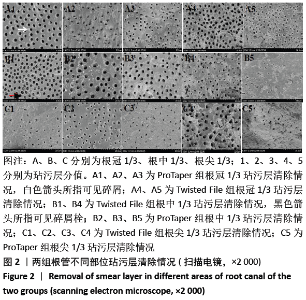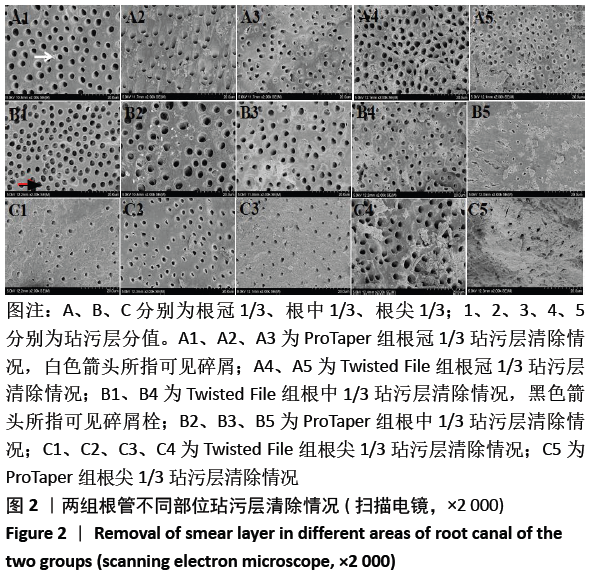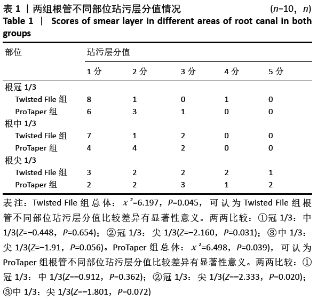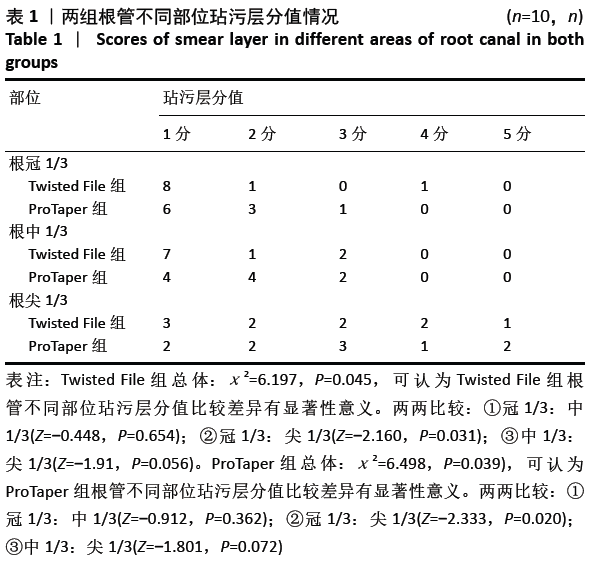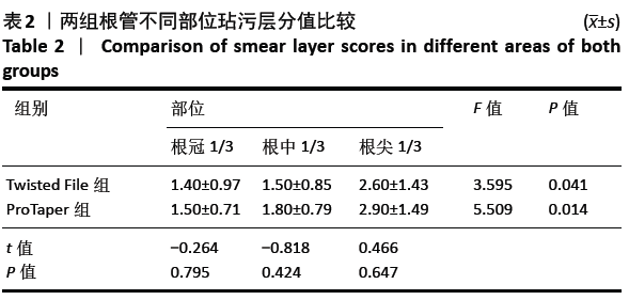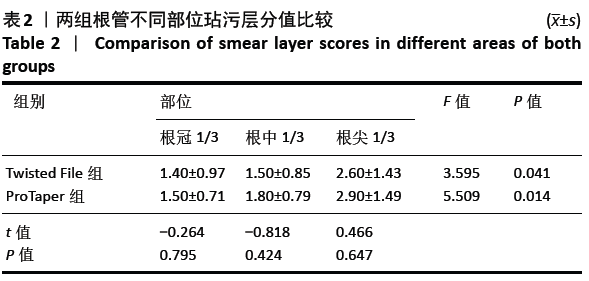[1] NG YL, MANN V, RAHBARAN S, et al.Outcome of primary root canal treatment: systematic review of the literature-part 1. Effects of study characteristics on probability of success. Int Endod J. 2007;40(12): 921-939.
[2] SIQUEIRA JF, ROCAS IN. Clinical implications and microbiology of bacterial persistence after treatme-nt procedures. J Endod. 2008; 34(11):1291-1301.
[3] YOU SY, KIM HC, BAE KS, et al. Shaping ability of reciprocating motion in curved root canals: a comparative study with micro-computed tomography. J Endod. 2011;37(9):1296-1300.
[4] 辛悦,杨健,宋矿余. XP-endo Finisher锉对根管内壁玷污层清除效果的体外研究[J].华西口腔医学杂志,2019,37(1):48-52.
[5] VIOLICH DR, CHANDLER NP. The smear layer in endodontics-a review. Int Endod J. 2010;43(1):2-15.
[6] 汤玉红,徐睿,朱倩,等.3种镍钛器械预备重度弯曲根管后牙本质微裂纹的观察[J].上海口腔医学,2019,28(6):581-585.
[7] BURKLEIN S, WERNEKE M, SCHAFER E. Impact of glide path preparation on the incidence of de-ntinal defects after preparation of severely curved root canals. Quintessence international (Berlin, Germa-ny:1985).2018:1-7.
[8] LI SH, LU Y, SONG DZ, et al. Occurrence of Dentinal Microcracks in Severely Curved Root Canals with ProTaper Universal, WaveOne, and ProTaper Next File Systems. J Endod. 2015;41(11):1875-1879.
[9] 孙菲,梁景平.不同镍钛根管预备器械去除重度弯曲根管内充填物的效果比较[J].口腔疾病防治,2019,27(10):627-633.
[10] KASIKCI Bİ, KOSELER İ, GUNERI P, et al. Efficiency and apical extrusion of debris: a comparative ex vivo study of four retreatment techniques in severely curved root canals. Int Endod J. 2017;50(9):910-918.
[11] GISELLE N, DIANA SA, LAILA GF, et al. Efficacy of ProTaper NEXT Compared with Reciproc in Removing Obturation Material from Severely Curved Root Canals: A Micro-Computed Tomography Study. J Endod. 2016;42(5):803-808.
[12] DEEPTHI S, DEVADATHAN A, JOSEY M, et al. Comparative evaluation of efficiency of single-file rotary and reciprocating systems in instrumenting severely curved mesial root canals of extracted mandibu-lar first molars: A morphometric study using cone-beam computed tomography. Saudi Endod J. 2019;9(2):119-125.
[13] YUAN GH, YANG GB. Comparative evaluation of the shaping ability of single-file system versus multi-file system in severely curved root canals. J Dent Sci. 2018;13(1):37-42.
[14] KIRCI D, DEMIRBUGA S, KARATAS E. Micro-computed Tomographic Assessment of the Residual Filling Volume,Apical Transportation, and Crack Formation after Retreatment with Reciproc and Reciproc Blue Systems in Curved Root Canals. J Endod. 2020;46(2):238-243.
[15] POLY A, FOUAD AM, MARQUES F, et al. Canal transportation and centering ratio after preparation in severely curved canals: analysis by micro-computed tomography and double-digital radiography. Clin- Oral Invest. 2019;23(12):4255-4262.
[16] ČESAITIENE G, VENSKUTONIS T, MACIULSKIENE V, et al. Micro-Computed Tomography (Micro-CT) Evaluation of Effects of Different Rotary Glide Path Techniques on Canal Transportation and Centeri-ng in Curved Root Canals. Med Sci Monit Int Med J Exp Clin Res. 2019;25: 6351-6358.
[17] BURROUGHS JR, BERGERON BE, ROBERTS MD, et al. Shaping ability of three nickel-titanium endodontic file systems in simulated S-shaped root canals. J Endod. 2012;38(12):1618-1621.
[18] 郑乾坤,张权,马会青,等.依替膦酸螯合剂清除根管内牙本质玷污层的研究[J].实用口腔医学杂志,2019,35(4):594-597.
[19] SCHNEIDER SW. A comparison of canal preparations in straight and curved root canals. Oral Surg Oral Med Oral Pathol.1971;32(2):271-275.
[20] MICHAEL H, CLAUDIA R, FRANK S. Root canal cleanliness after preparation with different endod-ontic handpieces and hand instruments: A comparative SEM investigation. J Endod. 1997;23(5): 301-306.
[21] HOMAN HJ, GHASEM HJ. A Comparison of Three Ni-Ti Rotary Instruments in Apical Transportation. J Endod. 2006;33(3):284-286.
[22] MARTIN B, ZELADA G, VARELA P, et al. Factors influencing the fracture of nickel-titanium rotary instruments. Int Endod J. 2003;36(4):262-266.
[23] GAMBARINI G, GRANDE NM, PLOTINO G, et al. Fatigue resistance of engine-driven rotary nickel-titanium instruments produced by new manufacturing methods.J Endod.2008;34(8):1003-1005.
[24] REDDY JM, LATHA P, GOWDA B, et al. Smear layer and debris removal using manual Ni-Ti files compared with rotary ProTaper Ni-Ti files-An In-Vitro SEM study. J Int Oral Health:JIOH.2014;6(1):89-94.
[25] SHARMA G, KAKKAR P, VATS A. A Comparative SEM Investigation of Smear Layer Remaining on Dentinal Walls by Three Rotary Ni-Ti Files with Different Cross Sectional Designs in Moderately Curved Canals. J Clin Diagn Res. 2015; 9(3):43-47.
[26] SCHÄFER E, ERLER M, DAMMASCHKE T. Comparative study on the shaping ability and cleaning efficiency of rotary Mtwo instruments.Part 2. Cleaning effectiveness and shaping ability in severely curved root canals of extracted teeth. Int Endod J. 2006;39(3):203-212.
[27] BÜRKLEIN S, HILLER C, HUDA M, et al. Shaping ability and cleaning effectiveness of Mtwo versus coated and uncoated EasyShape instruments in severely curved root canals of extracted teeth. Int Endod J. 2011; 44(5):447-457.
[28] LICHOTA D, NOWICKA A, WOŹNIAK K, et al.Cleanliness of the root canal walls after preparation with Mtwo rotary nickel-titanium instruments: a SEM study. Ann Acad Med Stetin. 2008; 54(3):58-62.
[29] BORGES MF, MIRANDA CE, SILVA SR, et al. Influence of apical enlargement in cleaning and extrusion in canals with mild and moderate curvatures. Braz Dent J. 2011;22(3):212-217.
|
